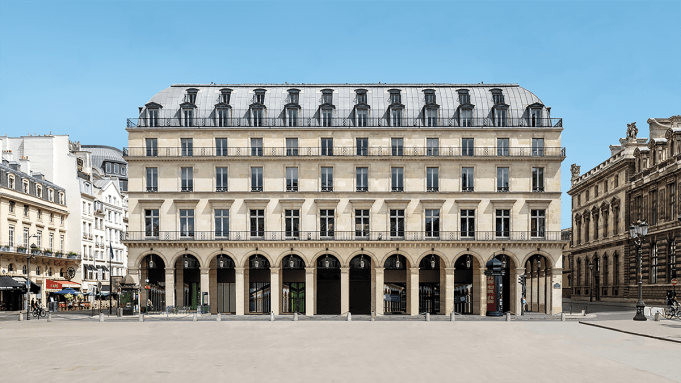When the Fondation Cartier pour l’art contemporain decided it had outgrown its Jean Nouvel–designed glass structure on Paris’s Left Bank, its hunt for new real estate led to apt quarters for a museum born from a luxury-goods empire: a former shopping mall.
“Shopping mall,” however, doesn’t quite do justice to the grand Haussmannian edifice—complete with a pale-yellow limestone facade, gracefully arched porticoes, ample wrought iron, and a classic zinc roof—on the Right Bank’s Place du Palais-Royal, where the institution opened on October 25.
To convert it into a 21st-century temple of art and design, the foundation again turned to Nouvel, the Pritzker Prize–winning French architect whose recent imaginative projects include the Louvre Abu Dhabi and the National Museum of Qatar. “Jean Nouvel is our architect since 40 years,” says Chris Dercon, managing director of the foundation. “He’s part of the family of the Fondation Cartier. It’s ideal to continue to work with an architect and to follow his or her development.”

Malick Sidibé, Combat des amis avec pierres, 1976, gelatin silver print, printed 2005.
Courtesy of Galerie Magnin-A, Paris
From Nouvel’s point of view, “That trust allows me to propose bold, unconventional ideas.” For the museum’s previous, apparition-like building, completed in 1994, he tells Robb Report, “I chose radical transparency. At Place du Palais-Royal, that approach could not be repeated—the heritage of the site called for a different architectural language. The idea of transparency remains essential, but the disruption has shifted inward, taking the form of a flexible architecture, open to the unexpected. Rather than designing a fixed model, I wanted to create a living instrument, one that can adapt to continuously evolving projects.”
His solution: a vast, hollowed-out hall with nearly 70,000 square feet of exhibition space—more than five times that of its former home—equipped with a system of five elevator-like platforms that promise a seemingly limitless number of configurations, vertically and horizontally. The concept of mobility enables “us to offer artists and curators the possibility to create their own Jean Nouvel building every six months,” says Dercon. “Think about it like Lego.”

A view of the new museum’s interiors.
Martin Argyroglo
The title of the inaugural exhibition, Exposition Générale, winks at shows of the same name that once filled French malls like this one with a hodgepodge of fashion, textiles, kitchenware, and art. With 500 works by 100 artists, it follows themes of design, nature, craft, and artistic interchange. Among the highlights: Malick Sidibé’s postcolonial photographs of Mali, a densely composed Sarah Sze installation, a Bernie Krause nature soundscape, and a joyfully vibrant salon de eventos, or reception hall, created in situ by Freddy Mamani, a leader of Neo-Andean architecture. “It’s very colorful. It’s very Baroque,” Dercon says of the latter. “Think of a 21st-century version of a Baroque mestizo church in the Andes.”
The foundation holds roughly 4,500 works in its collection, amassed over the 41 years since its inception. Most, he says, are by artists who “work in the margins” and don’t regularly appear at auction or mega galleries. “Our interests are very different from the encyclopedic [mission] of the Louvre, very different from the Musée des Arts décoratifs,” he notes. “I always say that we are interested in in-betweenness—in between the disciplines. We have always invited artists and curators and theoreticians to think in between the genres and also to work with one another.”

Architect Jean Nouvel created a system of mobile platforms in an effort to give artists and curators maximum flexibility.
Martin Argyroglo
Fondation Cartier has its own role to play in that last regard, as it joins a neighborhood already chockablock with museums and other landmarks. “It’s going to create an interesting dialogue with the Louvre, which is just in front of me, and it’s going to also create a very interesting dialogue with other buildings, like Tadao Ando’s Bourse de Commerce”—home of the Pinault Collection—“which is only four minutes away, and further down the road with the Tuileries, Hôtel de la Marine, Jeu de Paume,” Dercon says. “What we really want to avoid is this becoming a ‘museum mile.’ Our building is part of a mixed-use compound because above us are still offices. It’s good not to create a museum mile, not to have something which at night is going to feel like a mausoleum.”
Top: The Fondation Cartier pour l’art contemporain’s new home is inside the former Louvre des Antiquaires, a stone’s throw from the Louvre.

